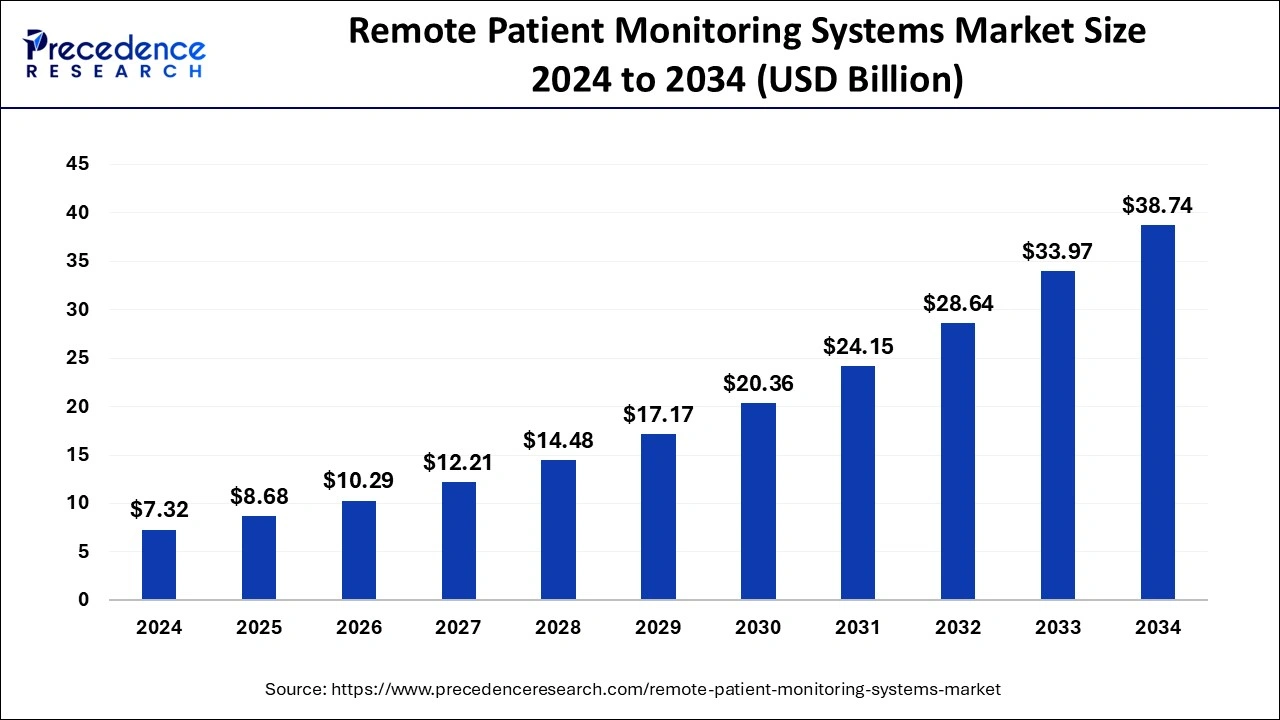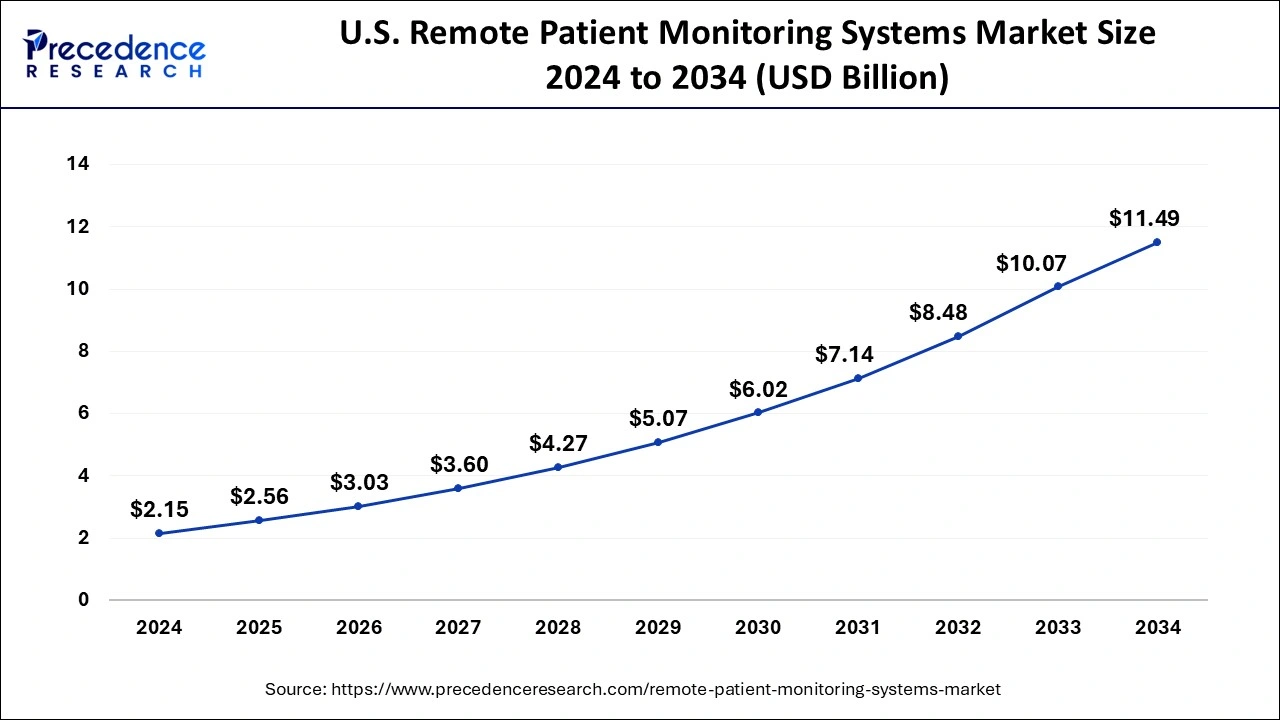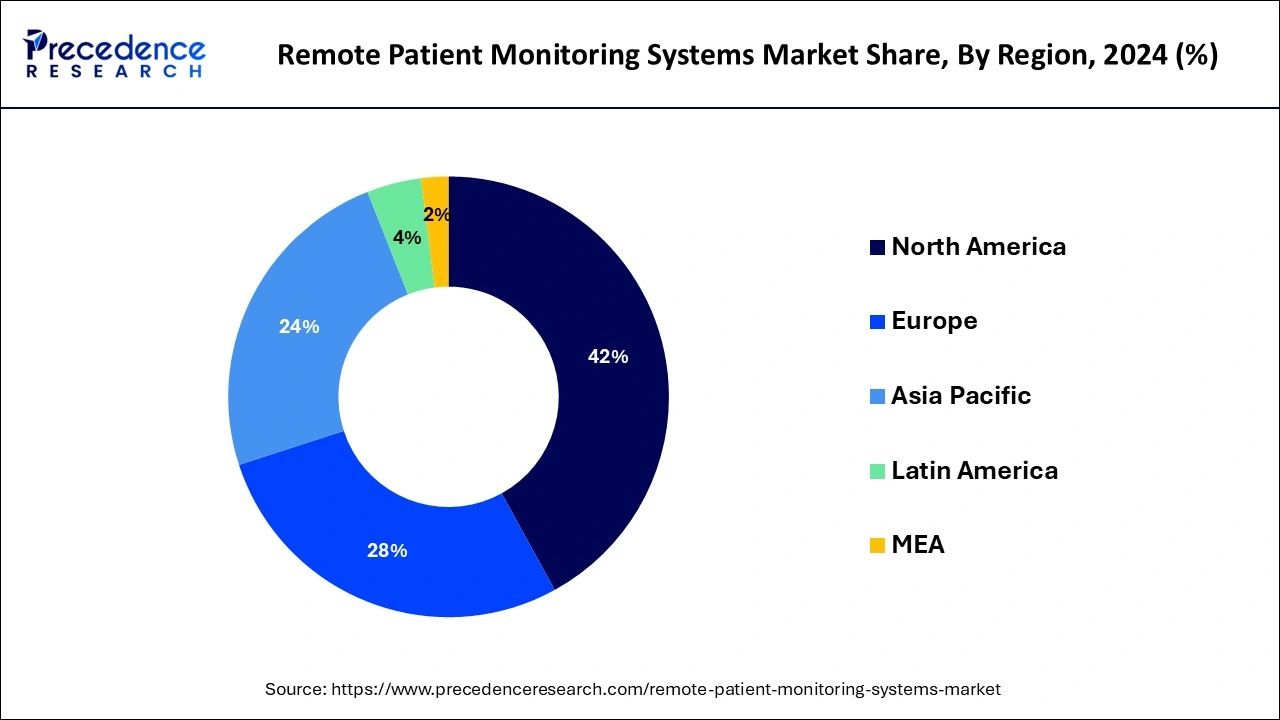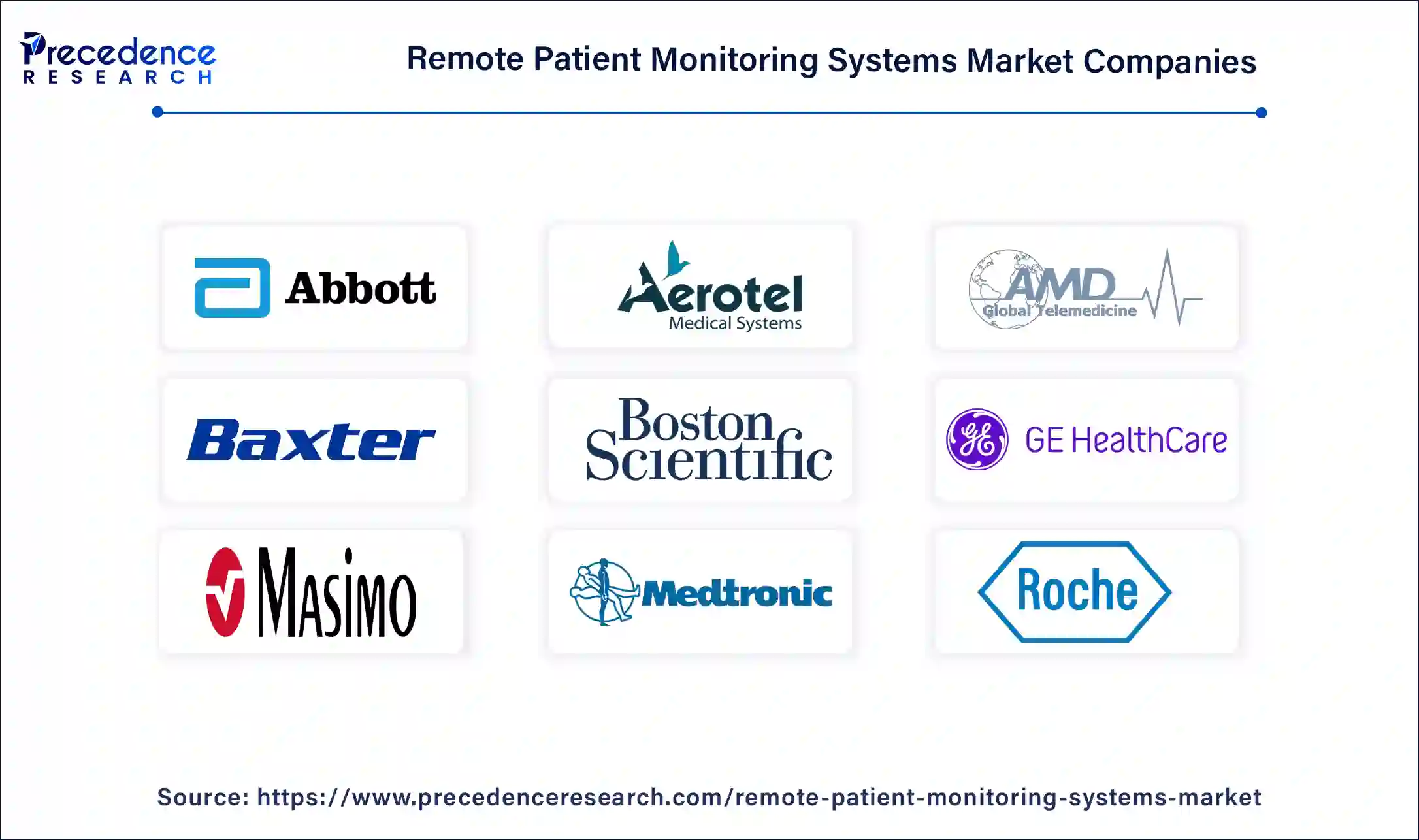List of Contents
What is Remote Patient Monitoring Systems Market Size?
The global remote patient monitoring systems market size accounted for USD 8.68 billion in 2025 and is predicted to increase from USD 10.29 billion in 2025 to approximately USD 38.74 Billion By 2034, growing at a CAGR of 18% from 2025 to 2034.

Market Highlights
- North America led the global market with the highest market share of 42% in 2024.
- Asia-Pacific is predicted to expand at the fastest CAGR during the forecast period.
- By Product, the specialized monitors segment held the largest market share of 81% in 2024.
- By Product, the vital sign monitors segment is anticipated to grow at a remarkable CAGR during the projected period.
- By Application, the diabetes segment had the biggest market share of 12% in 2024.
- By Application, the cardiovascular diseases segment is estimated to expand at the fastest CAGR over the projected period.
- By End-use, the hospital patients segment contributed more than 80% of revenue share in 2024.
- By End-use, the home healthcare segment is expected to grow at a noteworthy CAGR over the predicted period.
Market Size and Forecast
- Market Size in 2025: USD 8.68 Billion
- Market Size in 2026: USD 10.29 Billion
- Forecasted Market Size by 2034: USD 38.74 Billion
- CAGR (2025-2034): 18%
- Largest Market in 2024: North America
- Fastest Growing Market: Asia Pacific
Harnessing Artificial Intelligence to Enhance Remote Patient Monitoring
As of today, the AI-powered RPM system will render the highest safety alongside the lowest cost and the best patient outcomes. Predictive analytics would be used to identify complications in their earliest stages, develop care plans tailored to each individual patient, and engage the patient with real-time feedback. They maintained safety and reliability by catching anomalies early, which reduces adverse events. The lowered costs are due in part to fewer hospital nights, and a better allocation of resources. Patient outcomes would be best supported by improved chronic disease management, individualized care plans, and patient engagement. Remote patient monitoring would also provide care access to those who reside remotely or have mobility difficulties. Additional benefits would include quicker issue resolution, optimizing clinician workloads, and providing real-time insights.
Remote Patient Monitoring Systems Market Growth Factors
The increasing adoption of digital technologies in the global healthcare industry is significantly driving the remote patient monitoring (RPM) systems market. Further, the rising prevalence of various deadly diseases, growing geriatric population, and increasing incidences of road accidents is boosting the growth of the global RPM systems market. The demand for the RPM systems is rapidly growing among the old age population as this age group needs continuous monitoring of their health conditions. According to the Unite Nations, there were around 382 million old age people, aged 60 years or above, across the globe in 2017 ad this number is expected 2.1 billion by 2050. The rapidly growing geriatric population across the globe is expected to be the major driver of the RPM systems market in the foreseeable future. Moreover, rising disposable income, demand for the advanced healthcare facilities, and increased consumer expenditure on healthcare are the crucial factors the supplements the market growth across the globe.
The rising government initiatives and investments to build a strong and sophisticated healthcare infrastructure is boosting the demand for the latest technologies in the healthcare sector. Moreover, raising investments in the digitalization and automation in the healthcare units in order to increase the operational efficiency of the healthcare units is fueling the adoption of the RPM systems across various markets. The RPM systems provides enhanced diseases and health management by detecting the deteriorating health conditions early and tracks the progress in the health condition of the patients, which helps the healthcare units to offer improved patient care. The RPM systems can reduce hospitalization and chronic conditions that cost higher and hence help to save healthcare costs for the consumers. Hence, this factor may boost the adoption of the RPM systems in the forthcoming years.
Market Scope
| Report Coverage | Details |
| Market Size by 2025 | USD 8.68 Billion |
| Market Size in 2026 | USD 10.29 Billion |
| Market Size in 2034 | USD 38.74 Billion |
| Growth Rate from 2025 to 2034 | CAGR of 18% |
| Largest Market | North America |
| Base Year | 2024 |
| Forecast Period | 2025 to 2034 |
| Segments Covered | Product, Application, End User, and Region |
| Regions Covered | North America, Europe, Asia-Pacific, Latin America, and Middle East & Africa |
Market Dynamics
Drivers
Economic Benefit
Remote Patient Monitoring (RPM) systems provide an economical advantage by diminishing hospital readmissions, emergency visits, and the frequency of in-person
consultations. Such matters outlaying healthcare expenses to all entities, be they providers or patients. RPM enables continuous monitoring and early intervention for the betterment of patients' chronic condition status, thus circumventing any untoward developments. This direct medical care does away with those direct medical costs as the indirect costs go away as well, such as lost productivity. If health systems are on course to use resources optimally and obtain better outcomes, then cost-effectiveness within RPM will remain an overarching driving factor in its application all over the world.
Restraint
Issues in Reimbursement
One main problem restraining the adoption of RPM on a very large scale is the lack of clear reimbursement policies across various regions and insurance providers. Without some sort of established financial incentives or a standardized payment model in place, the health provider could be reluctant to develop RPM infrastructure and services. This blot of uncertainty blurs the deployment of technology and, eventually, its patients' access to RPM's benefits. Also, differing reimbursement criteria impede billing processes and add to administrative headaches. These reimbursement issues have to be resolved to allow for large-scale investment and incorporation of RPM systems into routine health care delivery.
Opportunity
Technological Advancements
Next-generation wearable sensors, enhanced wireless communication, and better data analytics are rapidly changing the face of the Remote Patient Monitoring (RPM) systems. With these technological improvements, we can expect systems that work more accurately, are easy to use, and remain well-connected to various patient groups. More advanced data analytics would allow introspection into patient health trends in greater detail, thereby enabling the formulation of personalized care plans and early detection of complications for any patient. As technology continues to progress, RPM devices have found themselves in better positions to be user- and pocket-friendly for patients themselves, which in turn has led to greater engagement and compliance. This increasingly more favorable panorama presents a strong platform for increased adoption of RPM globally and better health outcomes.
Segment Insights
Product Insights
The specialized monitors segment accounted for around 81% of the market share in 2024. This is attributed to the increased usage of specialized monitors in remotely monitoring the patient pre and post-surgery owing to its increased efficiency in monitoring clinical data. The introduction of advanced features like smartphones connectivity and wireless communication facilitates remote monitoring efficiently.
The vital sign monitors segment is projected to hit remarkable growth during the forecast period. This is attributed to the increased usage of these monitors for common purposes. The heart rate monitor is extensively used across the healthcare sector all over the globe. Furthermore, the surging prevalence of cardiovascular diseases is expected to boost the growth of this segment. According to the World Health Organization, around 17.9 million deaths were directly linked with the cardiovascular diseases in 2019, globally. This was around 32% of the global deaths in 2019.
Application Insights
Based on application, the diabetes segment accounted for 12% of revenue share in 2024. This segment was closely followed by the hypertension segment. The rising prevalence of diabetes across the globe resulted in the increased demand for the RPM systems for the diabetic patients. According to the World Health Organization, in 2019, around 1.5 million global deaths were directly linked to the diabetes. The unhealthy food habits among the global population are estimated to spur the growth in the number of diabetic population in the upcoming years.
The cardiovascular diseases segment is expected to be the fastest-growing segment during the forecast period. This is simply attributed to the rising prevalence of CVD among the population and the surging number of global deaths due to the CVD. According to the World Health Organization, around 17.9 million deaths were directly linked with the cardiovascular diseases in 2019, globally.
End Use Insights
Based on end use, the hospital patients segment accounted for over 80% of the market share in 2024. This is simply attributed to the increased presence of the hospitals in the developed nations and its rising penetration in the developing markets. The rising number of hospital admissions and the availability of advanced healthcare facilities in the private hospitals have exponentially contributed towards the growth of the hospital patients segment in the past few years.
The home healthcare segment is expected to witness the fastest growth during the forecast period. The rising disposable income, increased demand for convenience, and rising awareness regarding hospital acquired infections among the population are the major factors that can be held responsible for the growth of the home healthcare segment during the forecast period.
Regional Insights
U.S. Remote Patient Monitoring Systems Market Size and Growth 2025 to 2034
The U.S. remote patient monitoring systems market size is estimated at USD 2.56 billion in 2025 and is predicted to be worth around USD 11.49 billion by 2034, at a CAGR of 18.22% from 2025 to 2034.

How is the Notable Growth of the U.S. in the Market?
U.S. plays a major role in the North America market. The market growth is driven by presence of robust healthcare infrastructure, access to advanced diagnostic technologies, rising applications of digital biomarkers, ongoing clinical trials, increased use of remote patient monitoring systems in various healthcare settings, integration of telehealth services and rising disposable incomes. Implementation of artificial intelligence tools andInternet of Things (IoT) technology is encouraging the development of user-friendly and more sophisticated RPM devices.
Additionally, increased government influence through initiatives such as Rural Remote Monitoring Patient Act, Medicare Reimbursement and Hospital-at-Home Program are accelerating the adoption of RPM solutions
What Made North America the Dominant Region in the Remote Patient Monitoring Systems Market?
Based on region, North America accounted for around 42% of the market share in 2024. The increased awareness regarding the RPM systems, increased disposable income of the consumers, high adoption rate of advanced technologies in the healthcare industry, presence of developed healthcare infrastructure, growing geriatric population, and increased prevalence of various chronic diseases among the population are the major factors that developed the RPM market in North America.

What Makes Asia Pacific the Fastest-Growing Market for Remote Patient Monitoring Systems?
The Asia Pacific is expected to be the fastest-growing market during the forecast period. The rising consumer disposable income, increased healthcare costs, rising healthcare expenditure, and rising prevalence of chronic diseases in the region is fostering the adoption of the RPM systems in the region. Further, the rising government investments for the development of advanced healthcare infrastructure are expected to boost the growth of the market.
- For instance, in November 2024, the Sancheti Group of Hospitals, launched Pune's first “Smart Ward” initiative which is equipped with Dozee's AI-driven Remote Monitoring System (RMS) and Early Warning System (EWS) with the aim of enhancing patient safety, monitoring and care for improving health outcomes.
What are the Major Trends in India that Influence the Market?
India is a major contributor to the market thanks to its large and ageing population, strong government backing for telehealth and digital health infrastructure, and rapid adoption of connected healthcare solutions. The Indian government launched several initiatives to create a supportive and regulatory framework for implementing remote patient monitoring systems. Building digital infrastructure is crucial to enhance accessibility and ensure interoperability of remote monitoring data across various healthcare systems.
How is the Opportunistic Rise of Europe in the Remote Patient Monitoring Systems Market?
Europe is expected to experience significant growth in the remote patient monitoring systems market due to efforts to reduce healthcare costs and improve healthcare access. The EU-funded digital health initiatives aim to broaden access to telemedicine services. Germany's current legal framework supports digital health applications. Electronic patient records allow better data sharing and integration with digital health applications. Telemonitoring approaches are integrated into standard care, and the Digital Act aims to enhance the use of digital solutions in healthcare.
What Potentiates the Growth of the Latin American Remote Patient Monitoring Systems Market?
The market in Latin America is expected to grow at a steady rate in the coming years due to national digital health strategies and the expansion of existing telehealth infrastructure. The government has implemented telemedicine programs and established legal frameworks in countries such as Brazil, Argentina, Colombia, and Chile. Brazil leads the market, driven by public-private partnerships focused on digital health education and providing telehealth consultations and mobile health units. Some government initiatives aim to improve primary care access in urban and remote areas. They also emphasize the increased use of information and communication tools.
What Factors Drive the Growth of the MEA Remote Patient Monitoring Systems Market?
The market in MEA is driven by a shift toward home-based care and the demand for affordable healthcare. The MEA engages in international cooperation and foreign policy, and the favorable funding supports telemedicine infrastructure projects in other countries. Saudi Arabia is leading the market, driven by government initiatives to promote the use of many mobile applications that integrate telemedicine features. The remote healthcare services market is rapidly growing, led by supportive government policies. The inclusion of telehealth promotes home-based care and expands insurance coverage.
Remote Patient Monitoring Systems Market Companies

- Abbott Laboratories
- Aerotel Medical Systems
- AMD Global Telemedicine
- Baxter International Inc.
- Boston Scientific Corporation
- GE Healthcare
- Masimo Corporation
- Medtronic PLC
- F. Hoffmann-La Roche AG
- Omron Corporation
Recent Developments
- In July 2025, OMRON Healthcare partnered with Tricog Health to launch KeeboHealth, an AI-powered platform aimed at revolutionizing remote cardiac care in India, accelerating progress towards a 'Going for Zero' vision. (Source: https://thewire.in)
- In May 2025, eight digital health companies formed the Remote Monitoring Leadership Council to promote remote patient monitoring, improve care quality, and accelerate adoption. The council met with Trump Administration officials and Congress to strengthen RPM-enabled care. (Source:https://www.techtarget.com)
Key Companies & Market Share Insights
The market is moderately fragmented with the presence of several local companies. These market players are striving to gain higher market share by adopting strategies, such as investments, partnerships, and acquisitions & mergers. Companies are also spending on the development of improved products. Moreover, they are also focusing on maintaining competitive pricing.
- In August 2020, Johnson & Johnson invested in Thirty Madison, a telehealth company to participate in the digital health or e-health industry.
- In July 2020, Philips and BioIntelliSense collaborated to improve its RPM solutions by integrating the RPM system of BioIntelliSense to its product portfolio.
Segments Covered in the Report
By Product
- Specialized Monitors
- Vital Sign Monitors
By Application
- Diabetes
- Cancer
- Cardiovascular Diseases
- Weight Management
- Bronchitis
- Sleep Disorder
- Dehydration
- Virus
- Hypertension
By End Use
- Hospital Patients
- Ambulatory Patients
- Home Healthcare
By Region
- North America
- Europe
- Asia-Pacific
- Latin America
- The Middle East and Africa
For inquiries regarding discounts, bulk purchases, or customization requests, please contact us at sales@precedenceresearch.com
Frequently Asked Questions
Ask For Sample
No cookie-cutter, only authentic analysis – take the 1st step to become a Precedence Research client



